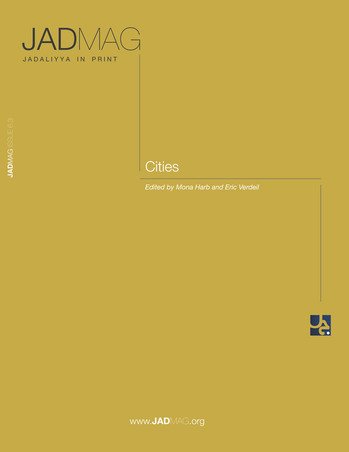
Many non-scholarly and scholarly accounts on the societies, culture, and political economy of the Middle East post-“Arab Uprisings/Spring” still deal with cities and regions as mere repositories of social, cultural, political, and economic action—despite the spatial turn that has informed social sciences and humanities for more than three decades.[1] Indeed, they often overlook the shaping roles of the built and natural environments in the production of events unraveling in cities and regions of the Middle East. We thus need to understand cities and regions not only as backgrounds and contexts for processes and practices, but rather as environments that have determining impacts on these, and that human interactions also shape.
Since its launch in September 2013, Jadaliyya’s Cities Page has been committed to producing such informed, empirical, and integrated knowledge, where the spatial engages and intersects with historical, political, economic, technological, legal, social, and cultural analysis. These are some of the questions we committed to address five years ago: How and why does urban space contribute to public action and social movements? What is the relationship between power, space, and resistance? How do different groups utilize space to mobilize and facilitate collective action? Which forces that shape space (physical and technological, as well as social, historical, political, and economic) are combined to guide this action? More broadly, how do specific historical, national policies, and global forces shape cities? How are different inequalities constituted by urban life and how do they reconstitute the city? How do the ordinary practitioners of the city negotiate, navigate, appropriate, resist, and transform urban forms? While many electronic outlets have been scratching the surface of such questions, focusing on formal aspects and general descriptions of urbanism, Jadaliyya Cities has been contributing to critical urban scholarship, and informing reflective practice and urban activism.
Instead of holding to generic stereotypes where things happen because of Islam, ideology, culture, sectarianism, and/or neoliberalism, a distinctive feature of the following chapters, initially released on Jadaliyya’s Cities page, is in their complex, intersectional, relational, and multidisciplinary narratives that do not reduce realities to simplistic formulations. The selected pieces produce critical knowledge on how and why economic geography determines places and regions, how urban politics and provision of services territorialize and distinguish spaces, how hierarchies and power are inscribed in legacies of land tenure systems, and how cultural geography and gendered socio-spatial practices transform a city’s neighborhoods. With such knowledge, we hope to inform and contribute to reflective urban practice and activism, and to cultivate the right to the city towards a “possible urban world.”
War and conflict have placed Middle Eastern cities under pressure, widely destroying their built environment, targeting the life of urban dwellers and dispersing them in order to (re)impose new political domination. Glastonbury and Kalioğlu show in their article how the Turkish government used the ghetto narrative to stigmatize and destroy historic Kurdish neighborhoods in South Anatolian cities. This rhetoric justified the uprooting of the popular base of the PDK (Kurdistan Democratic Party), while also serving political allies through the reconstruction and the public works undertaken by the TOKI public housing arm. As such, the violence that dissects and exhausts vibrant cities results in differentiated geographies that can only be understood, beyond the vagaries of fights and the variety of armed forces’ control, by excavating the urban geography and history of a particular city. Along the same lines, Giovanni Pagani provides a plausible explanation to why and how East Aleppo has been more durably mobilized in the Syrian conflict.
The case of Erbil reveals how cities are increasingly linked to the constantly shifting regional balance of power. Boissière and Morvan examine how the capital of the Kurdistan Republic of Iraq remained for many years marginalized in the authoritarian regime of Saddam Hussein. Oil money and regional scale capital investments, combined with the post-2003 political shift, which gave new margins of maneuver to local elites generated significant urban transformations. However, the instability produced by the Syrian war as well as the violent emergence of Daesh froze this urban growth, making of Erbil the shelter of thousands of refugees.
The current conflicts in and on Middle Eastern cities have indeed, once again, displaced large groups of people, leading to the sudden multiplication of planned and unplanned refugee camps. Kamel Doraï presents the case of the Zaatari camp in Jordan, which accommodates up to 125,000 Syrian refugees in makeshift dwellings. He shows how dwellers progressively appropriated their environment, adapting shelters to their needs, transforming them into homes, albeit temporary and precarious, enriching them with various facilities such as markets. Indeed, over time, camps become ordinary cities, even though for external observers they retain the infamous label of refugee camps, as the Dictaphone Group narrates in their article recounting the history of the Rashidiyeh Palestinian camp, near Tyre in Lebanon.
Beyond war, another common framework used to analyze cities in the Middle East region is neoliberalism. But, instead of general statements condemning this political economy, the two articles we feature here provide empirical accounts of the circuits of capital and the legal tools used to transform cities. Gebara, Khechen, and Marot produced an original dataset to analyze how the restructuring of municipal Beirut is taking place through extensive real estate investments, and to demonstrate how the reassembling of land parcels act as a key tool that fuels gentrification—the process by which older and often poor dwellers get evicted by upper middle class individuals and investors.
Moving to the other side of the Mediterranean, Koenraad Boegart examines globalization as a major force that does not merely operate externally but is very much located within cities, restructuring them from inside, as he discusses in the case of the Casa-Marina megaproject in Casablanca. In another chapter, his analysis is applied to the financialization of nature, revealing how the appropriation of land in the name of renewable energy and the fight against climate change also dislocates people. In both Moroccan stories, neoliberalization spurs its discontents, who struggle to preserve bits of their livelihoods and spatial practices, and more so to assert their own meanings and dignity in the face of disdain and capitalist violence. Such violence is epitomized in the new Justice Palace of Çağlayan, in Istanbul, analyzed by Ayşe Öncü. The Palace symbolizes the blending of Erdoğan’s authoritarianism with the hegemony of neoliberalism, which provides the building with the typology of a shopping center. Nonetheless, the palace is also the stage of small but persistent demonstrations of solidarity with the victims of Erdoğan’s recent purges.
The multiplicity of practices that dwellers perform and the diversity of meanings they assign to urban space challenge the widely circulating stereotypical representations of Middle Eastern cities portrayed as destroyed by violence or anesthetized by bigotry and patriarchy. Yaseen Raad’s chapter defies the common views of Baghdad as the theatre of bombings and explosions. He features its historically plural urban geography, which is still materialized, albeit weakly, in its parks along the river, bringing together young men and women, families, and elderly to enjoy magsuf and hookah under the summer breeze. Additionally, while others merely mention public squares as repositories of political action, Farha Ghannam unravels how and why Tahrir square is a heterotopic space that has been embodying protests for decades. In hommage to flânerie, Lana Salman’s chapter celebrates her fieldwork in Tunis as a rich collection of bodily encounters and stories of the everyday that always escape simplistic interpretations. And, in contrast to touristic clichés that complacently portray Beirut as the future of queerness, Maya Mikdashi underscores the embedded violence, domination and abjection that these images tend to blur, foregrounding the precariousness of livelihoods.
This JadMag closes with reflections on urban policies. Eric Verdeil’s article on the seemingly banal issue of lighting the city unravels the urban inequalities in the city and positions the claims of ordinary dwellers for street lighting vis-a-vis the financial and technical struggles of municipalities attempting to cope with these claims. Further highlighting the struggles of local governance, Mona Harb’s critiques the policy paradigm celebrating decentralization, as spearheaded by the Habitat III Lima conference and the new urban agenda, noting the pitfalls of retreating states, unequal resources, and unaccountable political systems that often result in inefficient and discriminatory practices.
________________________________________
[1] For further reading, see Edward W. Soja, Postmodern Geographies, The Reas- sertion of Space in Critical Social Theory (London: Verso, 2010).
For more information, go to the bibliography.

